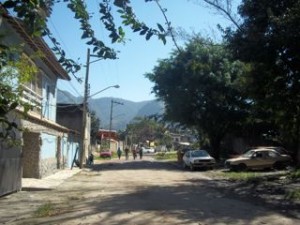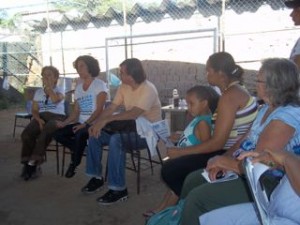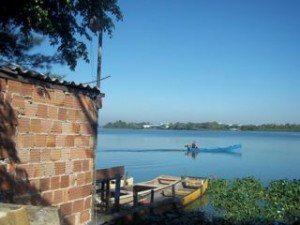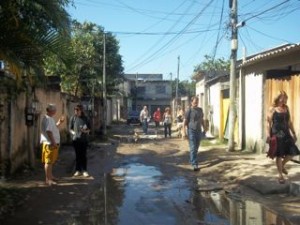 “Many people see the end of us, but I see the start,” said Inalva Mendes Brito, a Vila Autódromo resident at last weekend’s meeting in the community’s quad. In their fight against eviction, the community of Vila Autódromo which lies on land adjacent to where the 2016 Olympic Park will be built, has teamed up with experts from two federal universities to create the Plano Popular da Vila Autódromo, an urban, social, economic and cultural development project for the community.
“Many people see the end of us, but I see the start,” said Inalva Mendes Brito, a Vila Autódromo resident at last weekend’s meeting in the community’s quad. In their fight against eviction, the community of Vila Autódromo which lies on land adjacent to where the 2016 Olympic Park will be built, has teamed up with experts from two federal universities to create the Plano Popular da Vila Autódromo, an urban, social, economic and cultural development project for the community.
Taking into account all the issues, needs and legal requirements, the plan presents a wholly viable and economical alternative to the authority’s proposal to permanently remove the picturesque and peaceful West Zone community of 4000 residents.
Since October, urban planners, architects, engineers, geographers and social scientists from the Institute of Urban and Regional Planning at the Federal University of Rio de Janeiro (IPPUR-UFRJ) and the Urban and Housing Projects and Studies Nucleus at the Fluminense Federal University (UFF) have been working with the community to develop their own upgrading plan. Through extensive data collection, including interviews with residents and technical mapping, and a series of assemblies and workshops where residents made decisions in a collaborative, participatory process, they have created a holistic plan for the community’s future development.
 Inalva, a resident for 32 years who has been active in the plan’s development explains: “Having grown organically, favelas don’t have plans or projects. The institutional and systematic format for plans and projects that society demands is what we’re trying to do. It’s a plan that is technically, juridically viable to establish our rights to the city. Our rights are denied with the argument that we don’t have a plan, we’re disordered, we’re a favela and don’t have rights.”
Inalva, a resident for 32 years who has been active in the plan’s development explains: “Having grown organically, favelas don’t have plans or projects. The institutional and systematic format for plans and projects that society demands is what we’re trying to do. It’s a plan that is technically, juridically viable to establish our rights to the city. Our rights are denied with the argument that we don’t have a plan, we’re disordered, we’re a favela and don’t have rights.”
Like many favelas, basic sanitation and paving roads are some of the infrastructure improvements that Vila Autódromo requires. However with defined roads and plots and well-built houses, it doesn’t present some of the upgrading challenges associated with many of Rio’s favelas.
“The community has favorable conditions for upgrading,” explains Fabricio Leal de Oliveira, an urban planning professor from UFRJ. “Normally favelas are narrower and denser with smaller plots, which is much more difficult to upgrade. Here the plots are relatively regular… If the City wanted, they’d have urbanized this a long time ago. There’s nothing inconvenient. There isn’t any characteristic in this region that’s different from any other area in (the neighboring upscale neighborhood) Barra da Tijuca. In other words if you can have residences in Barra, you can here too.”
 One major issue for the community are the homes on the edge of the neighboring Jacarepaguá Lagoon and Pavuninha Canal. Some houses, including those that are more precariously constructed, back onto the water, bringing relate risks. The current legislation, updated in 1985 when the community already existed, demands a protected area of 30m between construction and the water, however the updated Federal Forest Code of 2008 states that in situations where there is social interest the protection strip can be 15m.
One major issue for the community are the homes on the edge of the neighboring Jacarepaguá Lagoon and Pavuninha Canal. Some houses, including those that are more precariously constructed, back onto the water, bringing relate risks. The current legislation, updated in 1985 when the community already existed, demands a protected area of 30m between construction and the water, however the updated Federal Forest Code of 2008 states that in situations where there is social interest the protection strip can be 15m.
Using the 2008 guidelines, the community and experts plan replacement accommodation within the community for the 86 families whose houses have to be removed. Vacant plots in the community itself will be used for apartment buildings of up to four storeys. “The problem can be solved within the community. There is no need to evict,” affirms urban planner Giselle Tanaka.
Patricia de Souza Santos, a mother of three whose house is on the edge of the water, fully supports the proposal. “The plan gives those living in a risk area a better place to live,” she says, adding, “I don’t support a move outside the community. What they need to do here are improvements in the community so that we can secure a future.”
Other improvements outlined in the plan include widening streets for water drainage, improved circulation, a leisure area, creche and renovation of the park. The planned works are designed to protect the environment and improve people’s quality of life.
 Despite experts and human rights campaigners agreeing that the community should remain and be upgraded, with one engineering journal recently calling the authorities’ plans for a highway (the most recent of five reasons given for this community’s removal) “completely unnecessary,” and a state land title granted in 1994 giving the community a 99 year concession, Vila Autódromo is still fighting to remain.
Despite experts and human rights campaigners agreeing that the community should remain and be upgraded, with one engineering journal recently calling the authorities’ plans for a highway (the most recent of five reasons given for this community’s removal) “completely unnecessary,” and a state land title granted in 1994 giving the community a 99 year concession, Vila Autódromo is still fighting to remain.
“The situation continues the same. It’s still not resolved” sighs Altair Antonio Guimarães, president of Vila Autódromo’s Resident’s Association. “They keep trying to implant in the community’s mind that there’s no other way, we have to leave, but it isn’t true.”
Threatened with removal for more than twenty years, the latest municipal government proposal under the premise of Olympic developments is understood by the community and others to be serving interests of real estate developers whose political connections have secured them 75% of the 1,180km2 Olympic park land after the Games. This despite the winning blueprints for the Olympic Park maintaining the community in place.
The recent purchase of land to build replacement apartment block housing and changes at the public defender’s office may work against the community, however residents are determined to protect the leafy, peaceful community that they variously described as “wonderful,” “paradise” and “a piece of heaven.” With a comprehensive, cost-effective, legally and technically sound plan for the community’s development to present to the mayor and municipal housing secretary next month, residents hope to win their right to stay.
